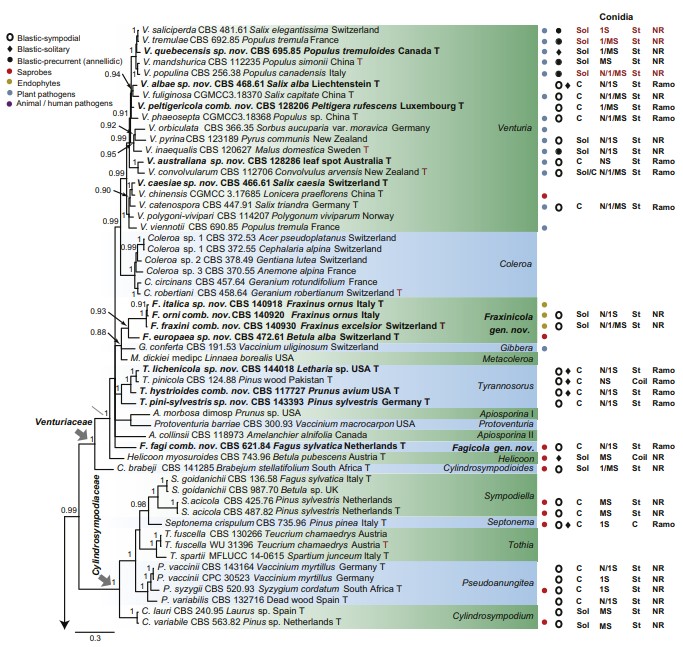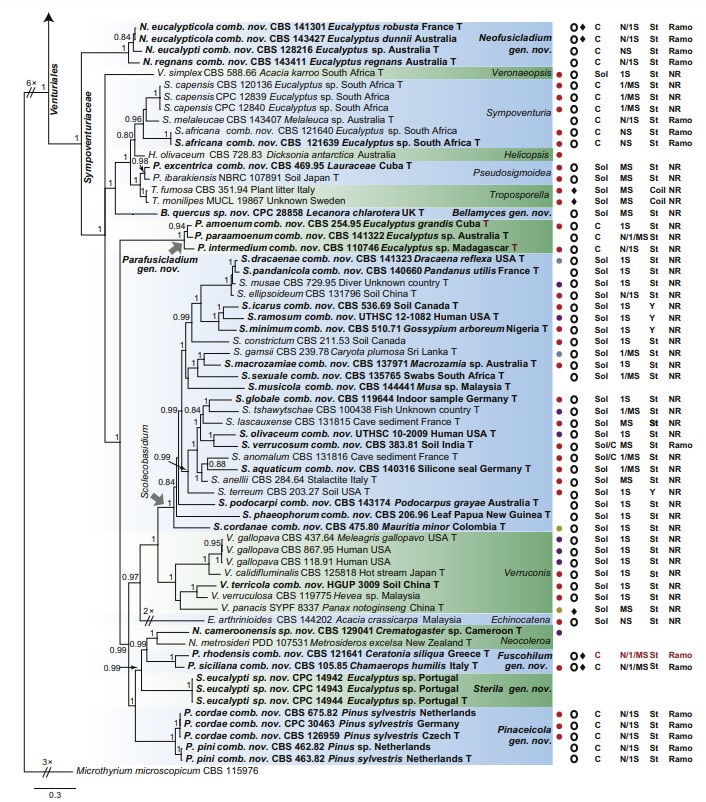Neofusicladium Crous, M. Shen & Y. Zhang ter, gen. nov.
Index Fungorum number: MB831512; Facesoffungi number: FoF 12040
Etymology: Named after the genus Fusicladium, to which it is morphologically similar, and neo- to new.
Mycelium consisting of pale to medium brown, smooth, branched, septate hyphae. Conidiophores reduced to con- idiogenous cells, or with basal supporting cell, solitary, erect, pale brown, smooth, subcylindrical to doliiform, sometimes dimorphic. Conidiogenous cells terminal or lateral, integrated, subcylindrical or doliiform, pale to medium brown, smooth, proliferating sympodial; conidiogenous loci somewhat thick- ened and darkened, not refractive. Ramoconidia brown, smooth, subcylindrical or fusoid-ellipsoid, aseptate or septate. Conidia mostly occurring in branched chains, pale brown, smooth, subcylindrical to fusoid-ellipsoidal, aseptate or septate, sometimes widest in middle, truncate at the ends; hila somewhat darkened and thickened, but not refractive (adapted from Crous et al. 2010, 2016, 2017).
Type species: Neofusicladium eucalypti (Crous & R.G. Shivas) Crous, M. Shen & Y. Zhang ter
Notes: – So far, Neofusicladium comprises three species, viz., N. eucalypti, N. eucalypticola and N. regnans. All three Neo- fusicladium species were isolated from Eucalyptus leaves (Crous et al. 2010, 2016, 2017). The diagnostic characteristics of Neofusicladium includes sympodial conidiophores with some- what thickened and darkened, non-refractive conidiogenous loci, mostly branched conidial chains, and the presence of ramoco- nidia (Crous et al. 2010, 2016, 2017). Phylogenetically, Neo- fusicladium is basal in Sympoventuriaceae and is introduced as a new genus (Fig. 1).

Fig 1. Consensus phylogram (50 % majority rule) of 691 952 trees resulting from a Bayesian analysis of the combined alignment of ITS, LSU, tef1, tub2 and rpb2 sequences of Venturiales. Bayesian posterior probabilities (PP) > 0.80 are shown at the nodes and the scale bar represents the expected changes per site. Some branches were shortened to facilitate layout. The tree was rooted with Microthyrium microscopicum (CBS 115976). Culture collection numbers, substrates and countries are indicated behind the species names. Those highlighted in bold are new taxa or new combinations proposed in this study, and type strains are marked with “T” (ex-type in black, ex-epitype in red). Relevant morphological characteristics plotted are abbreviated as follows: Sol – conidia solitary, C – conidia in chains, NS – aseptate conidia, 1S – 1-septate conidia, MS – multi- septate conidia (septa ≥ 2), St – straight or slightly curved conidia, Coil – coiled conidia, Y – Y-shaped conidia; Ramo – ramoconidia present, NR – ramoconidia not observed;
? – asexual morphology not available (either from references or from sporulation induced in this study); and morphological characters plotted in red means strains failed to sporulate in this study and plotted values are taken from the original description, observation of this study or related references. Other characteristics are explained in the legend.

Fig 1. (Continued).
Species
